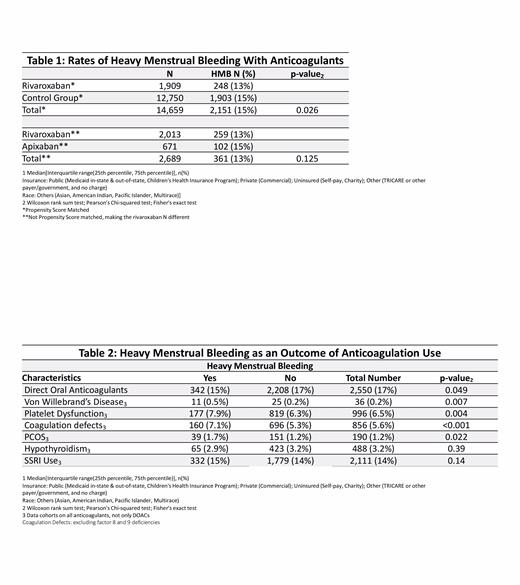Background
Direct oral anticoagulants (DOACs) - Dabigatran, Rivaroxaban, and Apixaban - are increasingly being used in the pediatric and adolescent population. DOACs have been shown to increase the likelihood of heavy menstrual bleeding (HMB) in adult women of childbearing age, when compared to vitamin K antagonists or low molecular weight heparins (LMWH). There are limited data regarding the prevalence of HMB in the adolescent population on DOACs. Pivotal trials leading up to the approval of DOACs in the adolescent and pediatric populations also failed to prespecify prospective analyses on the impact of DOACs on HMB. The effect of HMB and its treatment burden can contribute to the compliance rates of DOACs in this population, adding to the recurrence rates of venous thromboembolism. Our study aims to assess the rate of HMB with DOAC use in adolescents by comparing the rate of HMB and its associated healthcare burden to patients on other anticoagulants.
Methods
This is a retrospective cohort study conducted with deidentified data obtained from the Pediatric Health Information System (PHIS) database after IRB approval. The PHIS is a comparative database with clinical and resource utilization data for inpatient, ambulatory surgery, ED, and observation unit encounters from more than 49 children's hospitals. ICD-10 codes were used to query the data for pediatric patients between the ages of 9-18 years on anticoagulant therapy from January 2020-December 2022. DOAC group was defined as patients on Rivaroxaban, Dabigatran, or Apixaban at any point in their care. The control group was defined as patients on anticoagulants other than DOACs, such as LMWH, unfractionated heparin, coumadin, and bivalirudin. Data extracted included any episode of HMB (diagnosis codes for abnormal uterine bleeding, dysfunctional uterine bleeding, menorrhagia, or heavy menstrual bleeding), risk factors for HMB other than anticoagulants, and healthcare utilization data for HMB such as number of ED visits, hospital admission and length of stay, and ICU admission. For the Descriptive statistics, demographics and clinical characteristics of the patients were described using median and interquartile range (25th percentile, 75th percentile) for continuous variables, and frequency and percentages for categorical variables, as appropriate. Control group was matched to the DOAC group by propensity score matching using nearest method with the ratio 1:5 to generate the similar pairwise comparison. Categorical variables were analyzed with the chi-square test; continuous variables were assessed by Mann Whitney U test or Kruskal-Wallis rank sum test. P-value of less than 0.05 was considered as statistically significant for the analysis. All the analysis were performed using SAS software, version 9.4 (SAS Institute, Cary, NC) and R software, version 4.2.2
Results
Of the total sample size of 87,119 patients on any anticoagulant, 84,411 (96.8%) patients were in the control group and 2,708 (3.1%) in the DOAC group before propensity matching. Of the three DOACs studied, 2013 were in Rivaroxaban group (74%), followed by Apixaban (671 or 25%) and Dabigatran (24 or 1%). Rates of HMB in patients on the largest DOAC group, Rivaroxaban vs the control group, and Rivaroxaban vs Apixaban are as shown in table 1.There was no significant difference in healthcare burden between the DOAC and control groups (p-value 0.954) with no difference in length of stay between the two groups (5 days for both groups). The rate of HMB with the use of DOACs or with known risk factors of HMB on any anticoagulant is as shown in table 2.
Conclusion
In contrast to adult patients, our study suggests similar rates of HMB in adolescents on DOACs when compared to the control group. Rivaroxaban was the most commonly used DOAC in our data set. Though the number of patients on Apixaban was small, there was no difference in the rate of HMB between Rivaroxaban and Apixaban groups. Patients with known risk factors of HMB had an increased rate of HMB with all anticoagulants. Prospective studies are needed to further elucidate the impact of DOACs and other anticoagulants on HMB in adolescents.
Disclosures
Ahuja:State of Ohio Rare Disease Advisory Council: Membership on an entity's Board of Directors or advisory committees; TraumaChek: Patents & Royalties; ClotChip: Patents & Royalties; XaTec Inc: Research Funding; CSLBehring: Honoraria; Sanofi: Honoraria; Genentech: Honoraria; NovoNordisk: Honoraria.


This feature is available to Subscribers Only
Sign In or Create an Account Close Modal